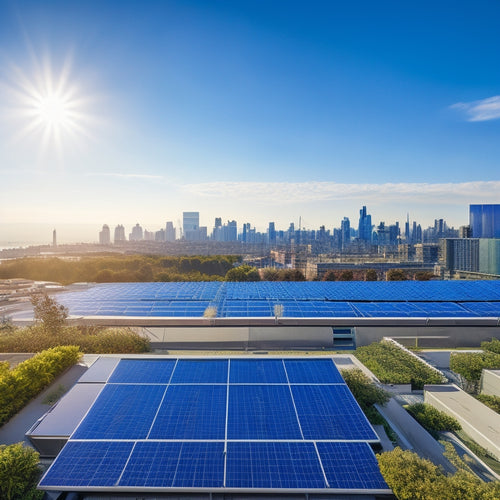
Buying Solar Panels With Warranty: a Step-By-Step Guide
Share
Start by researching brands with high-efficiency ratings and strong customer service reputations. Assess your energy needs by reviewing past electricity bills and projecting future usage. Examine warranty terms closely, including coverage duration, inclusions, and exclusions—25 years for performance and 10-25 years for product warranties are standard. Check customer reviews and certification standards like IEC 61215 and UL 1703 for reliability. Compare installation services, considering contractor certifications and long-term savings. Finally, evaluate purchase options, factoring in financing, incentives, and robust warranties. Taking these steps will help guarantee your investment in solar panels meets your needs and expectations. Let's explore each step further.
Key Takeaways
- Research efficiency ratings, durability, and warranty terms to choose a reputable brand with high-quality products.
- Analyze historical electricity usage to determine your average monthly energy consumption and future needs.
- Review warranty terms, focusing on coverage duration, inclusions, exclusions, and claim process details.
- Check customer reviews and certification standards for insights into performance, durability, and safety.
- Evaluate installation services, considering contractor certifications, labor costs, and potential financing plans or rebates.
Research Different Brands
https://www.youtube.com/watch?v=GEZO67JJ19I
When researching different brands of solar panels, prioritize their efficiency ratings, durability, and warranty terms to guarantee long-term sustainability and cost-effectiveness. Start by examining each brand's reputation; a strong reputation often correlates with high-quality products and reliable customer service.
Look for brands with consistently high efficiency ratings, as these panels will convert more sunlight into electricity, maximizing your energy output and savings.
Durability is another critical factor. Panels exposed to harsh weather conditions need to be resilient. Check for certifications that indicate robust performance under various environmental stressors. A well-established brand will typically offer a variety of products tailored to different climates and installation types, giving you the flexibility to choose the best option for your specific needs.
Warranty terms are equally important. A thorough warranty indicates the manufacturer's confidence in their product's longevity and performance. Look for warranties that cover both the product and its performance over an extended period, typically 25 years. Such warranties not only protect your investment but also ensure long-term reliability.
Determine Your Energy Needs
To accurately determine your energy needs, start by analyzing your household's historical electricity usage data over the past year. Gather your utility bills and note the kilowatt-hours (kWh) used each month. This data reveals patterns in your energy consumption, highlighting periods of peak usage and helping you understand your overall energy profile.
Next, calculate your average monthly energy consumption. Sum the kWh for all twelve months, then divide by 12. This average provides a baseline for your solar panel requirements. However, don't stop there. Examine your peak usage months—typically during extreme weather conditions—to guarantee your solar system can handle these periods without relying heavily on grid electricity.
Factor in any future changes that might affect your energy needs. Are you planning to purchase an electric vehicle or add new appliances? Anticipate these adjustments to avoid undersizing your system.
Check Warranty Terms
When evaluating warranty terms, focus on the coverage duration details to understand the long-term value.
Analyze the inclusions and exclusions to see what specific aspects of the solar panels are protected.
Additionally, familiarize yourself with the claim process steps to guarantee you can efficiently address any potential issues.
Coverage Duration Details
Understanding the coverage duration of solar panel warranties is crucial for evaluating long-term reliability and return on investment. When examining warranty terms, pay attention to the warranty period and coverage limitations.
Most solar panels come with a performance warranty of 25 years, guaranteeing that the panels will produce a certain percentage of their original capacity over time. However, the product warranty, which covers defects and workmanship, typically ranges between 10 to 25 years.
You need to scrutinize these durations because they vary between manufacturers and directly impact your system's sustainability and financial viability. A longer product warranty period often indicates a higher level of trust from the manufacturer in their product's durability.
Moreover, carefully review the coverage limitations. These restrictions might include specific conditions under which the warranty is void, such as improper installation or environmental damage.
Understanding these aspects ensures you're not caught off guard by any unexpected costs, allowing you to maximize your investment's potential and contribute to a sustainable future.
Always compare different manufacturers and their warranties to choose the most thorough and reliable option for your needs, aligning your choices with both financial freedom and environmental responsibility.
Inclusions and Exclusions
Thoroughly inspect the inclusions and exclusions in the warranty terms to avoid unforeseen expenses and guarantee the longevity of your solar panel system. You must be aware of what the warranty covers and what it doesn't to make informed decisions. Pay close attention to coverage limits and liability exclusions, as these can have a substantial impact on your investment's sustainability.
| Inclusions | Exclusions |
|---|---|
| Defects in materials and workmanship | Damage from natural disasters |
| Performance guarantees | Improper installation |
| Specific component failures | Modifications without manufacturer approval |
Knowing the inclusions helps you understand what the manufacturer commits to fixing, such as defects in materials and workmanship, performance guarantees, and specific component failures. This clarity ensures your solar panel system's efficiency and durability over time.
On the flip side, exclusions like damage from natural disasters, improper installation, and unauthorized modifications can nullify your warranty. These liability exclusions highlight areas where you might bear the financial burden. By scrutinizing these terms, you can take preventive measures to safeguard your system and avoid costly repairs.
Approach this assessment with a data-driven mindset and sustainability focus, ensuring your solar investment aligns with your liberation goals. Understanding these terms empowers you to maintain your system's longevity effectively.
Claim Process Steps
To initiate a warranty claim, first review the detailed steps outlined in the warranty terms to make sure compliance and streamline the process. Start by gathering all necessary documentation requirements, such as your proof of purchase, installation records, and the warranty certificate. Accurate documentation is essential to substantiate your claim and avoid any unnecessary delays.
Next, identify the contact methods specified by the manufacturer. This could include email, phone, or an online claims portal. Each method might've different procedures, so following the correct one guarantees your claim is processed efficiently. When you reach out, be clear and concise, providing all required information upfront.
Sustainability-focused users will appreciate that many manufacturers today use digital platforms for claims, reducing paper waste and improving efficiency. By adhering to these streamlined processes, you're not just resolving an issue—you're participating in a more sustainable future.
Compare Prices Online
Leverage online comparison tools to analyze the cost variations among different solar panel brands and models. Start by visiting reputable websites that specialize in price comparison. These platforms aggregate data from multiple vendors, enabling you to quickly identify the best online deals. By examining metrics such as wattage, efficiency, and price per watt, you can make an informed decision that aligns with your sustainability goals.
Utilize filters to sort options based on your specific requirements, like panel type (monocrystalline or polycrystalline), warranty period, and manufacturer reputation. Many tools also offer side-by-side comparisons, allowing you to see detailed specs and pricing information at a glance. This data-driven approach ensures you don't just settle for the first option you encounter.
Additionally, take advantage of seasonal sales and manufacturer rebates, which can significantly reduce your upfront costs. Don't forget to factor in potential installation fees and any local incentives or tax credits you might be eligible for. This holistic perspective will help you achieve both financial and environmental liberation.
Read Customer Reviews
Customer reviews provide invaluable insights into the real-world performance and reliability of solar panels, helping you make a data-driven purchasing decision. To guarantee you're investing in quality panels, it's essential to scrutinize review authenticity and employ sentiment analysis to gauge overall customer satisfaction. By doing this, you can separate genuine feedback from potentially biased or fake reviews.
When reading customer reviews, focus on these key aspects:
-
Performance Over Time: Look for reviews that discuss the solar panels' efficiency and durability over several years. This will give you an idea of their long-term reliability.
-
Warranty Claims: Pay attention to how customers describe the warranty process. Are claims honored quickly and efficiently? This reflects the manufacturer's commitment to customer service.
-
Installation and Maintenance: Reviews that detail the ease of installation and any maintenance issues provide practical insights into what you can expect post-purchase.
Using sentiment analysis tools can help you identify common themes and issues in customer reviews, providing a clearer picture of overall sentiment. This data-driven approach ensures you're making an informed decision, ultimately leading you to a more sustainable and liberating investment in solar energy.
Verify Certification Standards
Verifying that your solar panels meet recognized certification standards is essential for validating their quality, safety, and performance. Start by identifying the certification authorities such as the International Electrotechnical Commission (IEC), Underwriters Laboratories (UL), and the Solar Rating & Certification Corporation (SRCC). These organizations rigorously test and certify solar panels, ensuring they meet stringent criteria for efficiency, durability, and safety.
In your verification process, check for IEC 61215 and IEC 61730 certifications. IEC 61215 pertains to the long-term reliability of photovoltaic (PV) modules, while IEC 61730 focuses on the safety aspect. These certifications are vital for guaranteeing that your solar panels can withstand environmental stressors and operate safely over their lifespan.
Additionally, consider the UL 1703 certification, which signifies compliance with North American safety standards. Panels certified by SRCC, particularly those with OG-100 ratings, have been tested for thermal performance and reliability, making them ideal for solar water heating systems.
Evaluate Installation Services
When evaluating installation services for your solar panels, start by comparing installation costs to make sure you're getting a fair price.
Check contractor certifications to confirm they meet industry standards and have the necessary expertise.
Compare Installation Costs
Assessing installation services is important to guarantee you're getting the best value and quality for your solar panel investment. When comparing installation costs, you'll want to carefully examine both labor costs and material expenses to make sure you're making a sustainable choice that aligns with your financial and environmental goals.
Firstly, labor costs can vary greatly between contractors. Look for detailed quotes that break down hourly rates, projected timeframes, and any additional fees. This transparency helps you avoid hidden charges and ensures you're comparing apples to apples.
Secondly, material expenses are an essential part of the overall cost. Installation materials like mounting brackets, wiring, and inverters can impact both the price and efficiency of your system. Make sure to ask for a detailed list of materials and their respective costs.
Lastly, consider the long-term savings from energy efficiency and reduced utility bills. While upfront costs are important, the true value lies in the system's performance over its lifespan.
Balancing these factors ensures you're making an informed, sustainable investment in your solar energy future.
-
Labor Costs: Detailed quotes, hourly rates, and additional fees.
-
Material Expenses: Detailed list of materials and costs.
-
Long-term Savings: Energy efficiency and reduced utility bills.
Check Contractor Certifications
Ensuring the installation is performed by certified contractors adds an extra layer of reliability and quality to your solar panel investment. Start by conducting a thorough license verification. Licensed contractors have met specific standards and regulations, ensuring they possess the requisite skills and knowledge. This step minimizes risks associated with improper installation, which can jeopardize your warranty and system efficiency.
Next, scrutinize their professional credentials. Look for certifications from recognized bodies such as the North American Board of Certified Energy Practitioners (NABCEP). These credentials indicate that the contractor has undergone rigorous training and adheres to industry best practices. Additionally, check if they're members of professional organizations, which often require adherence to codes of ethics and continuous education.
Data supports that certified installers notably reduce system underperformance and maintenance needs. According to a National Renewable Energy Laboratory (NREL) study, systems installed by certified professionals showed a 15% higher performance ratio compared to those installed by non-certified individuals.
Assess Service Experience
Evaluating the installation services of potential contractors is crucial to guarantee your solar panel system's long-term efficiency and reliability. Start by examining their customer support and service reliability. A contractor with strong customer support indicates they'll be responsive to your needs, from initial consultation to post-installation maintenance.
To make an informed decision, consider these key aspects:
-
Service History: Research their track record. Look for customer reviews, case studies, and project portfolios. Reliable contractors often have documented success in similar installations.
-
Technical Expertise: Verify the qualifications and experience of their installation team. Skilled technicians are more likely to handle complex installations efficiently, minimizing downtime and maximizing system performance.
-
After-Sales Support: Evaluate the contractor's commitment to post-installation services. Effective after-sales support ensures that any issues are promptly addressed, safeguarding your investment and promoting sustainability.
Make the Purchase
When making the purchase, prioritize solar panels that offer robust warranties to guarantee long-term performance and sustainability. Look for warranties that cover at least 25 years for both product and performance. This secures your investment remains protected against defects and degradation over time. Consider companies that back their warranties with a strong financial foundation, as this provides additional peace of mind.
Next, explore various payment options and financing plans. Many solar providers offer flexible payment structures, including zero-down financing, leasing, and power purchase agreements (PPAs). Evaluate the total cost of ownership under each plan, factoring in interest rates, monthly payments, and potential savings on energy bills. Data-driven decision-making tools, such as cost-benefit calculators, can help you compare these options effectively.
Additionally, research incentives and rebates available in your region. Government programs and tax credits can greatly reduce your upfront costs, enhancing the financial viability of your solar investment. Always make sure that the terms of these incentives align with your chosen financing plan.
Frequently Asked Questions
How Do I Maintain My Solar Panels Post-Installation?
To maintain your solar panels post-installation, perform regular cleaning to maximize efficiency. Remove debris monthly to prevent shading and optimize light capture. This sustainable practice guarantees peak performance, liberating you from high energy costs and environmental impact.
What Should I Do if My Solar Panels Stop Working?
If your solar panels stop working, start by contacting your installer. They'll guide you through troubleshooting steps. This technical approach guarantees efficient resolution, leveraging data and sustainability to maintain your energy independence and environmental commitment.
Are There Tax Incentives for Purchasing Solar Panels?
Did you know you can save up to 26% with federal credits? Many states also offer incentives, making solar panels a smart, eco-friendly investment. These savings empower you to embrace sustainability and financial freedom simultaneously.
How Can I Monitor the Performance of My Solar Panels?
You can monitor your solar panels' performance by using a monitoring system that tracks energy output in real-time. This data-driven approach guarantees peak efficiency and sustainability, freeing you from reliance on traditional energy sources.
What Happens to My Warranty if I Sell My Home?
When you sell your home, the warranty's transfer policy usually kicks in, allowing the new homeowner to enjoy the buyer benefits. Confirm that the warranty is transferable to maintain sustainability and freedom through continued energy efficiency.
Related Posts
-

Solar Power Savings for Environmentally Aware Consumers
Switching to solar power lets you drastically cut your carbon footprint while saving money in the long run. Each kilo...
-

Business Solar Investments for Cost-Effective Sustainability
Investing in solar energy is a smart move for your business, providing a solid foundation for cost-effective sustaina...
-

Affordable Sustainable Building Materials for Homes
You can build an eco-friendly home on a budget by choosing affordable sustainable materials. Consider using reclaimed...


